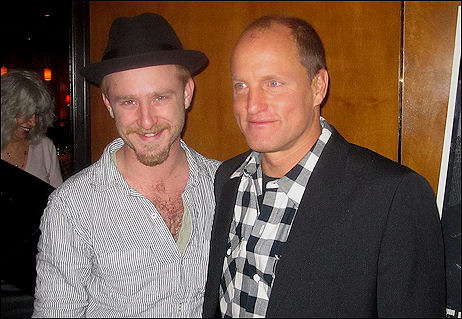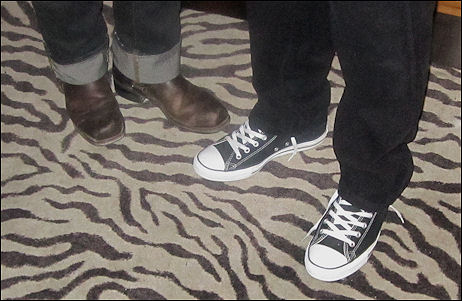
The Messenger costars Ben Foster, Best Actor hopeful Woody Harrelson at today’s Monkey Bar press luncheon.

Foster and Harrelson’s footwear.


I guess the only surprise among the WGA nominees today is the Best Original Screenplay nom for James Cameron‘s Avatar. This, I presume, was a recognition of good story bones — the well-configured structure and the way it all pays off like a slot machine in the fourth act — more than the dialogue, which few seem to admire.
The other mind-bender was nominating Jon Lucas and Scott Moore‘s script of The Hangover in the same category.
Otherwise congrats to nominees Mark Boal (The Hurt Locker), Joel Coen & Ethan Coen (A Serious Man), Scott Cooper (adapted screenplay nominee for Crazy Heart), Nora Ephron (Julie & Julia), Geoffrey Fletcher (Precious), Robert Orci and Alex Kurtzman (Star Trek) and Jason Reitman and Sheldon Turner (Up in the Air).
Eric Rohmer, the celebrated, meditative and peculiar French director whose films were once famously dismissed by Gene Hackman‘s private detective in Arthur Penn‘s Night Moves (1975) as “sorta like watching paint dry,” died several hours ago at age 89.
I read the news around 2:15 pm or so, as I was leaving the Monkey Bar lunch for The Messenger. “Another great one gone,” I muttered. A legend, a major-league auteur, a pantheon guy. But I didn’t feel all that much because I’ve never felt much for his films. I’ve always respected them, but have never felt much rapport.
I can honestly say I’ve never rented or re-watched Claire’s Knee, The Marquise of O, The Aviator’s Wife, Perceval, Chloe in the Afternoon or My Night at Maud’s. after seeing them theatrically (or at a screening). They’re all worth the time, of course. I wouldn’t want to dissuade. I’ve just never been a huge fan. Is that permissible?
Others can wet themselves over the just-announced restored Bluray/DVD of John Huston‘s The African Queen (Paramount Home Video, 3.23). But not me. Not until I see it, I mean. You can’t trust anyone these days, and you definitely can’t trust anyone putting out a restored version of a three-strip Technicolor film that’s nearly 60 years old.
The portions of The African Queen with genuinely rich and bountiful colors are those that were shot on a London sound stage. The African location footage portions are great for authenticity and verisimilitude but they”re grainy and desaturated and nothing to write home about. So don’t get too excited. The film is only going to look as good as it’s going to look, or as good as it looked on theatre screens in 1951, which wasn’t any kind of drop-your-pants Technicolor orgasm experience to begin with.
The Bluray Queen may turn out to be a more luscious and detailed rendering than anything seen before, and I’ll be delighted as anyone else if this happens. Or it may turn out to be a very decent-looking, not-bad, in-and-out version covered with billions of digital mosquitoes (on top of the actual mosquitoes that Humphrey Bogart and Katherine Hepburn have to cope with on the Ulanga).
All I know is that I’ve been burned before and you can’t trust Bluray technicians to do the right thing. Not necessarily because they might be grain Jihadists. Or maybe original dp Jack Cardiff, who was shown the restored digital version and signed off on it before he died, was a grain fanatic. You never know. You can’t trust anyone. Grain monks will not go quietly into that good night. If by clapping my hands three times I could make them disappear, I would clap my hands three times.
All of the different Queens (Bluray, single disc, boxsets) will feature a doc called Embracing Chaos: Making The African Queen, featuring interviews with Martin Scorsese and others. The box sets will also include an “audio disc recording of the original Lux Radio Theater broadcast of The African Queen, a reproduction of Katharine Hepburn’s out-of-print memoir “The Making of The African Queen or How I Went to Africa with Bogart, Bacall and Huston and Almost Lost My Mind,” a Senitype film frame reproduction and postcard reproductions” of images from the film.
Yesterday the N.Y. Times online guys posted a fascinating interactive map-graph of Netflix viewing habits in 12 major cities — N.Y., L.A., Miami, Boston, Seattle, Dallas, Minneapolis, Denver, Atlanta, S.F. Bay Area, Chicago, Washington. Everything you might have suspected about the demos for various films are clearly visualized. Dark red represents the most intense interest — pale yellow and white reps low or zero interest. You can’t stop laughing.


I wrote something important last May about the annual Oscar season wars that needs to re-posted every year. I was responding to a then-recent A.O. Scott N.Y. Times rant about the many offenses of the Oscar show. “Do something!,” he said. In an almost touching submisssion to the nihilistic impulse, Scott also suggested that the Oscars be killed.
To which I responded: “Rejigger and rejuvenate by all means, obviously, but never kill the Oscars. Never. Not because the show itself is anything close to magnificent (although we all derive fleeting emotional charges each and every year), but because every Oscar season is like a great spiritual Olympics. Because each and every film of any merit and our reactions to them are opportunities for assessing our values, lives, beliefs — the whole magillah.
“Because the Oscars, of course, are only nominally about the competing films. They’re really about how we feel and think about these films, and what we’re looking or hoping for each time we enter a theatre and submit to the dark. In short, they’re about us.
“Each year the Oscar race allows — demands — that we assess who we are, what we need and want, what defines artistic greatness or at least distinction, and the kinds of spells and meditations that films need to provide.
“Every day I’m looking to understand and sometimes redefine who I am and what I want, but we all do this en masse during Oscar season. It’s a stirring, at times joyously argumentative process. (I loved trashing Chicago and praising The Pianist in ’02 — it was all to the good.)
“For me, the October-to-February argument is all, or certainly 95% of the game. The show is maybe 5% of it — the end, the crescendo, the cherry on top, whatever. And through all of it the distributors of the films in the arena, the ones that each year compete and strive and receive the constant attention, clearly benefit.”